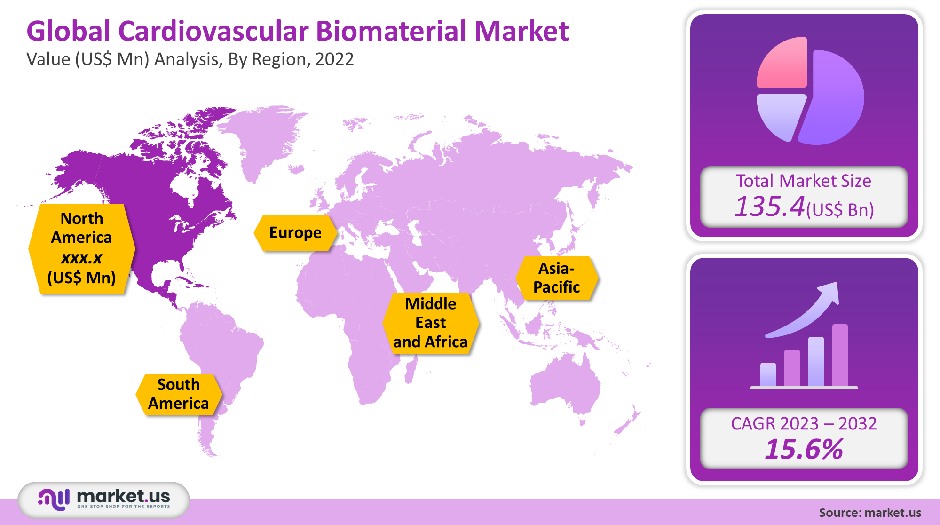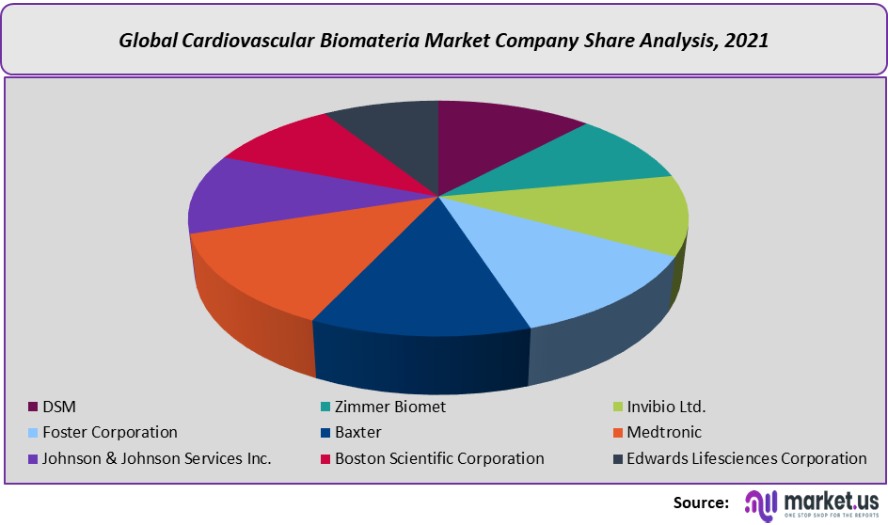Cardiovascular Biomaterial Market By Type (Natural, Ceramic, Metallic, Polymer), By Product ( Catheters, Stents, Implantable Cardiac Defibrillators, And Others), and by Region and Companies Industry Segment Outlook, Market Assessment, Competition Scenario, Trends and Forecast 2022-2032.
- Published date: Feb 2022
- Report ID: 83786
- Number of Pages: 355
- Format:
- keyboard_arrow_up
Cardiovascular Biomaterial Market Overview:
The Cardiovascular Biomaterial Market is projected to reach a valuation of USD 667.04 Bn by 2032 at a CAGR of 15.6%, from USD 135.4 Bn in 2021.
A biomaterial is a substance that has been engineered to interact with biological systems for a medical purpose, either a therapeutic or a diagnostic one. There are two types of biomaterials: synthetic and natural. Metals, polymers, and ceramics are examples of traditionally defined synthetic materials.
Native tissues from autogenic (same individual), allogenic (same-species donor), or xenogenic (animal) sources are used to make natural biomaterials. Animal tissues, such as those from cows or pigs, are used to create nonhuman tissues. In medical applications, inert biomaterials have historically been preferred to limit reactivity with the biological tissues with which they come into contact.
Examples that do not react chemically with the surrounding environment are biologically inert gold dental fillings and titanium metal implants used in hip replacements.
Polymers, metals, or a combination of both are the most common synthetic biomaterials used in cardiovascular applications. Ceramics are employed in cardiac therapy to a considerably lower extent. The main benefits of synthetic materials are their strength and durability, although their biocompatibility difficulties might present complications.
Toxicity is a major problem when it comes to synthetic materials, especially biodegradable materials that might release potentially toxic byproducts into the body. Chemically inert materials have shown to be a useful foundation for implantable materials, allowing for stand-alone use or medication administration via coatings.

Detailed Segmentation
Based on Type:
- Natural
- Ceramic
- Metallic
- Polymer
Based on Product:
- Catheters
- Stents
- Implantable Cardiac Defibrillators
- Pacemakers
- Sensors
- Heart Valves
- Vascular Grafts
- Guidewires
- Ventricular Assist Devices
Based on Region:
- North America
- Europe
- Asia-Pacific
- South America
- Middle East & Africa
Market Dynamics
Drivers for the Global Cardiovascular Biomaterial Market:
The increasing prevalence of Cardiovascular Diseases (CVDs) is a primary factor in this market’s economic growth. Cardiovascular diseases are caused due to various factors such as unhealthy diets, physical inactivity, smoking, and stress.
Geriatric populations are another major element for this market as the probability of developing CVDs increases with age. According to the World Health Organization (WHO), over 17 million people die from CVDs every year, and this number is expected to increase to more than 23 million by 2030.
Technological advancements are also fueling this market’s revenue growth as these advancements enable manufacturers to develop new products and improve existing ones.Restraints Global Cardiovascular Biomaterial Market:
Strict regulations concerning the approval of biomaterial products, all of which require clearance that they are safe and effective before being marketed, are a primary reason impeding the further expansion of the cardiovascular biomaterial market. Additionally, the high cost of biomaterial production, as well as inflammatory reactions caused by compatibility concerns, are also factors that are expected to pose a significant impediment to this market’s further expansion.
Opportunities for the Global Cardiovascular Biomaterial Market:
This market is characterized by the significant presence of unmet clinical needs necessary for better CVD treatment options. This has led to the development of novel biomaterials that can be used in the treatment of CVDs.
Increasing geriatric populations, as well as a greater awareness concerning CVDs, are elements anticipated to create lucrative opportunities for this market player in the years to come.
Trends for the Global Cardiovascular Biomaterial Market:
Degradable metallic substances might replace corrosion-resistant metals that are now employed for stent applications because it has been shown that the role of stenting is short-term and inadequate for the duration of 6–12 months after joining, during which arterial remodeling and curing occur.
Competitive Landscape
- DSM
- Zimmer Biomet
- Invibio Ltd.
- Foster Corporation
- Baxter
- Medtronic
- Johnson & Johnson Services Inc.
- Boston Scientific Corporation
- Edwards Lifesciences Corporation
- Mölnlycke Health Care AB

Recent Developments of Major Players
- In 2019, Royal DSM (Netherlands) and ProMed Pharma (US) collaborated to research innovative sustained release drug delivery technologies in the polymeric drug delivery sector.
![Cardiovascular Biomaterial Market Cardiovascular Biomaterial Market]() Cardiovascular Biomaterial MarketPublished date: Feb 2022add_shopping_cartBuy Now get_appDownload Sample
Cardiovascular Biomaterial MarketPublished date: Feb 2022add_shopping_cartBuy Now get_appDownload Sample - DSM
- Zimmer Biomet
- Invibio Ltd.
- Foster Corporation
- Baxter International Inc Company Profile
- Medtronic
- Johnson & Johnson Services Inc.
- Boston Scientific Corporation Company Profile
- Edwards Lifesciences Corporation
- Mölnlycke Health Care AB
- settingsSettings
Our Clients
|
Single User
$5,999
$2,999
USD / per unit
save 50% |
Multi User
$7,999
$3,499
USD / per unit
save 55% |
Corporate User
$12,999
$4,499
USD / per unit
save 65% | |
|---|---|---|---|
| e-Access | |||
| Data Set (Excel) | |||
| Company Profile Library Access | |||
| Interactive Dashboard | |||
| Free Custumization | No | up to 10 hrs work | up to 30 hrs work |
| Accessibility | 1 User | 2-5 User | Unlimited |
| Analyst Support | up to 20 hrs | up to 40 hrs | up to 50 hrs |
| Benefit | Up to 20% off on next purchase | Up to 25% off on next purchase | Up to 30% off on next purchase |
| Buy Now ($ 2,999) | Buy Now ($ 3,499) | Buy Now ($ 4,499) |








